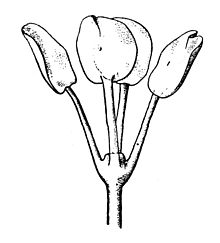Tetraphyllidea
| Tetraphyllidea | |
|---|---|

| |
Scolex of a tetraphyllid
| |
| Scientific classification | |
| Domain: | Eukaryota |
| Kingdom: | Animalia |
| Phylum: | Platyhelminthes |
| Class: | Cestoda |
| Subclass: | Eucestoda |
| Order: | Tetraphyllidea Carus, 1863 |
| Families | |
| |
Tetraphyllidea is a large
scolex morphologies
, which are the most varied and morphologically complex amongst all tapeworm orders.
Tetraphyllidean
cetaceans, the role of these apex predators
in the tetraphyllidean life cycle is not well known; whales and dolphins may be definite or dead-end hosts.
bothridia ("sucking grooves") on its scolex.[2] Its proglottids, which are the segments of tapeworms that contain the reproductive structures, are longer than wide when immature, and become wider than long at maturity.[2] However, the proglottids at each stage are generally the same shape.[2] C. antonioi also have crenulated bothridial margins and a microthrix pattern that varies from other species in Crossobothrium.[2] The most notable and unique quality of C. antonioi is the large amount of testes per mature proglottid.[2] C. antonioi has more than 700 testes per proglottid, whereas other Crossobothrium species have ~150-300 testes per proglottid.[2]
References
